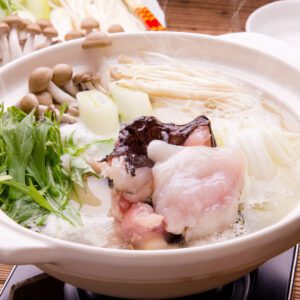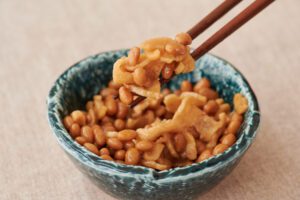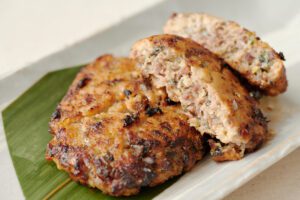Ibaraki Prefecture’s local cuisine recommended in February
Table of contents
1. Introduction
The recommended local dishes in Ibaraki prefecture in February are “Monkfish cuisine” and “Soboro natto”. Both have been selected as one of the “100 selections of local dishes” selected by the Ministry of Agriculture, Forestry and Fisheries. “Monkfish cuisine” in Ibaraki prefecture is famous all over the country, and natto is also famous under the “Mito natto” brand. It is natural that “Monkfish cuisine” and “Soboro natto” are selected as “100 selections of local dishes”. In addition, “Soboro Natto”, which is also a preserved food, can be eaten all year round.
2. Monkfish cuisine
The National Federation of Fisheries Cooperatives has selected “PRIDE FISH” in winter in Ibaraki Prefecture, “Ibaraki monkfish” (season: December-February) and “Ibaraki Joban Masaba (chub mackerel)” (season: November-January). Since they use this “Ibaraki anglerfish”, there is no reason why the “anglerfish dishes” in Ibaraki prefecture are not delicious.
“Monkfish cuisine” is a dish such as “Anko Nabe”, “Tomozu-ae”, and “Dobu jiru (soup)”. Anko Nabe is a hot pot containing monkfish fillets. Dobu jiru is a miso hot pot made only with monkfish and vegetable such as radish without using water. The liver of monkfish melts and the juice becomes cloudy like a dobu (ditch), so it is called “Dobu jiru”.

Anko’s “Tomozu-ae” is a dish of boiled monkfish dipped in liver-filled vinegar miso. We can eat Anko Nabe and Dobu Jiru outside of Ibaraki Prefecture, but “Tomozu-ae” is a dish unique to Ibaraki Prefecture. Therefore, it can be said that the most typical dish that should be mentioned as a local dish of Ibaraki prefecture is “Tomozu-ae.”

Source: Ministry of Agriculture, Forestry and Fisheries website
As pointed out in “Seafood in season in Feb (No.2),” the catch of monkfish in Ibaraki Prefecture is the fourth largest in Japan. Ibaraki Prefecture’s anglerfish is more about taste than about quantity. As it has been called “Western blowfish and eastern monkfish” for a long time, it is famous all over the country for its taste, and that is why I think it has been selected as one of the “100 Best Local Cuisine”.
3. Soboro Natto
“Soboro Natto” is a dish of natto and chopped dried daikon seasoned with soy sauce. You can enjoy the difference in texture between natto and kiriboshi daikon. Since it lasts for a long time, it can be used as a preserved food. “Soboro natto” is also called “shoboro natto”. “Shoboro” is a dialect of “soboro”.
It is said that the word “soboro” was named “soboro natto” because it expresses a shabby and detailed appearance.

Source: Ministry of Agriculture, Forestry and Fisheries website
Although there are no statistics, Ibaraki Prefecture is said to be the largest producer of natto in Japan. Like the “Mito Natto” brand mentioned above, Ibaraki Prefecture is a prefecture where the image of natto stands out. However, according to the 2020 household survey, the per capita natto expenditure in Mito City, Ibaraki Prefecture was the 5th largest in major cities (Yen 6,228 per year). Fukushima City (Yen 7,251) is ranked first, Yamagata City (Yen 6,543) is ranked second, Morioka City (Yen 6,460) is ranked third, and Sendai City (Yen 6,228) is ranked fourth. In any case, it is surprising that Mito City, which is famous as “Mito Natto”, is not the number one in Japan. The catch of monkfish is also the 4th in the whole country, so I want the people of Ibaraki to aim for the 1st place in the whole country not only in quality but also in quantity.
4. Paita-yaki
Unfortunately, the Ministry of Agriculture, Forestry and Fisheries’ “Local dishes loved by the nation” has not been selected from Ibaraki Prefecture. Here, we will take up “Paita-yaki” as a local dish of Ibaraki prefecture.

Source: Ministry of Agriculture, Forestry and Fisheries website
“Paita-yaki” is a fisherman’s dish in which pacific saury and sardines are finely chopped, mixed with spices such as green onions and ginger, miso and eggs, and the flour is connected to form an oval shape. It can be said that it is a dish similar to “San ga Yaki” in Chiba prefecture, which is made by chopping horse mackerel into small pieces and mixing it with condiments.
As pointed out in “Seafood in season in Feb (No.2)”, the characteristic of fishing in Ibaraki Prefecture is that 96% of the catch is purse seine fishing. Purse seine fishing is a fishing method for catching fish that migrate in large groups (mure) such as mackerel, sardines, and horse mackerel. In 2020, Ibaraki Prefecture’s catch will be No. 1 in Japan for sardines and No. 3 in Japan for mackerel. Ibaraki Prefecture’s unique local cuisine that catches such migratory fish can be said to be “Paita-yaki.”
In addition, “Paita” is a paddle for rowing a boat, and it is called “Paita-yaki” because the sailor hits saury and sardines on the flat part of the paddle and grills it.
